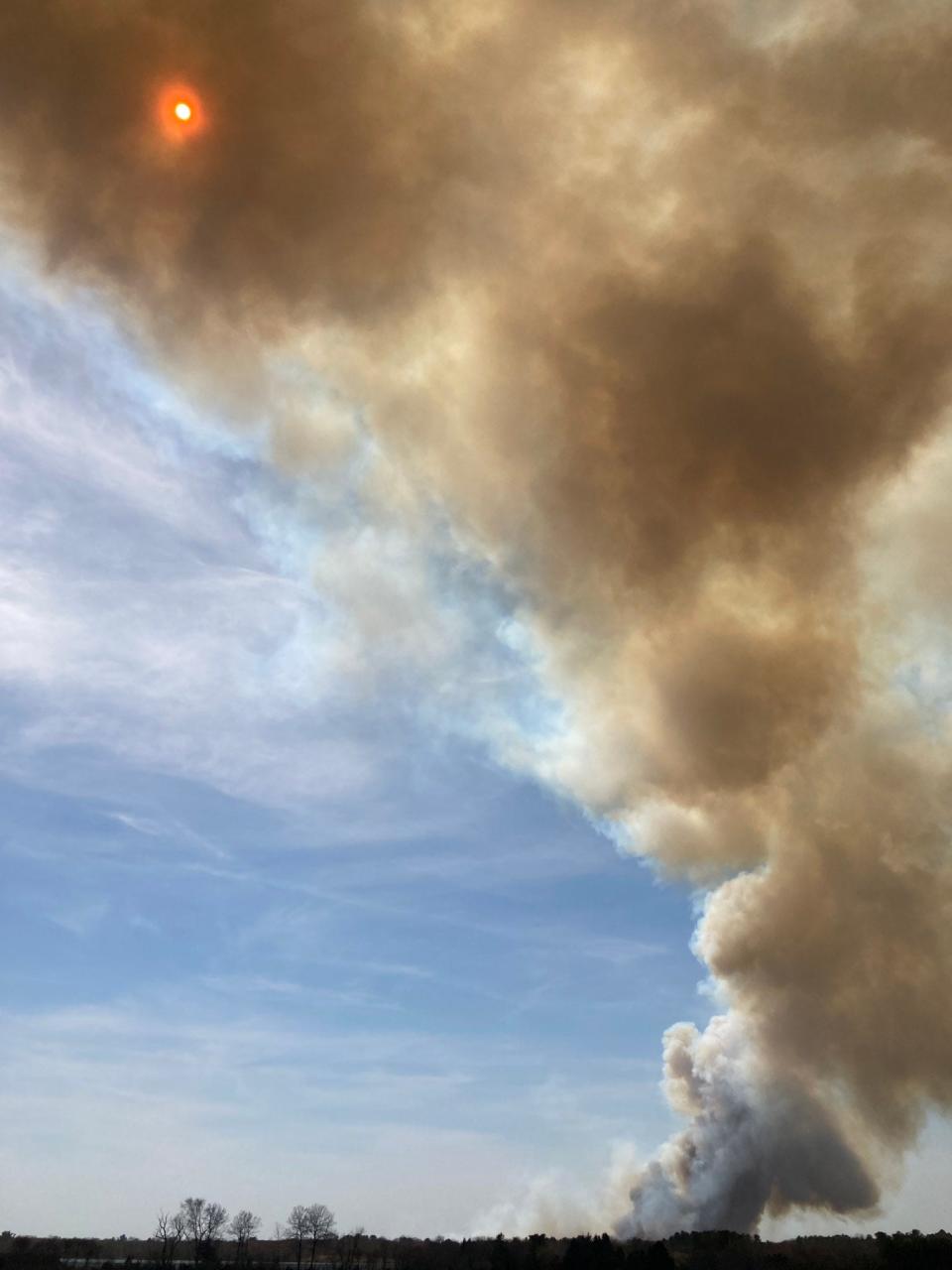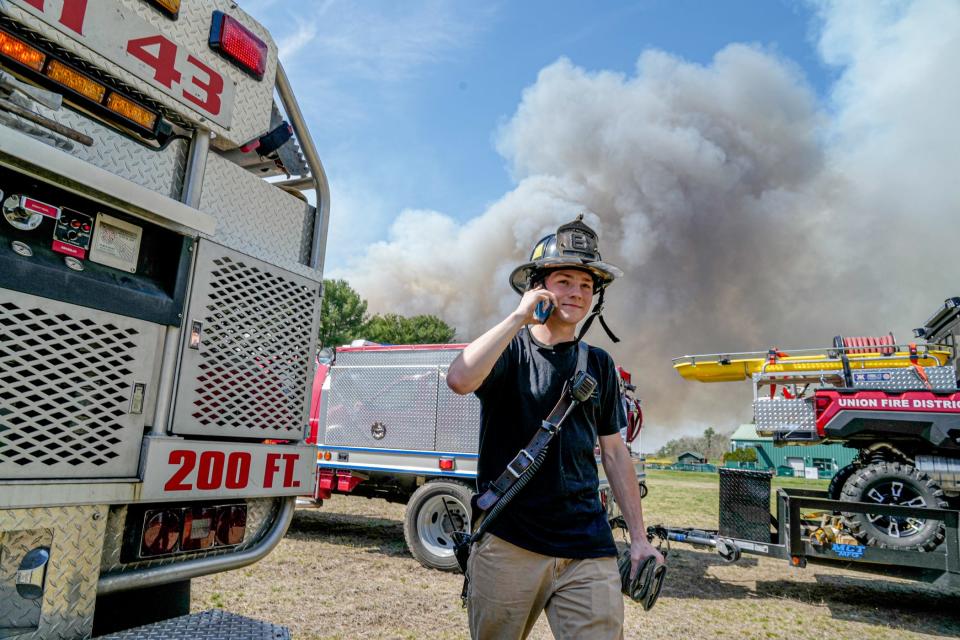RI's largest wildfire in decades exposed key problems. Here's what may change as a result.
The 350-acre wildfire that tore through Exeter last spring could end up inspiring a concerted effort to map long-overlooked fire access roads in wooded areas throughout the state, and financial incentives for private landowners who are willing to make certain changes on their own properties.
Those ideas were among the suggestions that drew widespread consensus among members of the Rhode Island House of Representatives' forest management commission, which is tasked with formally presenting a series of recommendations to the General Assembly by the end of the month.
The commission, chaired by Rep. Megan Cotter, D-Exeter, was formed in the wake of last April's devastating blaze in the Queen's River Preserve — the largest wildfire that Rhode Island has seen since 1942. Fire chiefs and other experts have testified about a wide variety of problems that the fast-burning fire brought into sharp focus, while emphasizing that the outcome could have been much worse.

How the panel is proposing to lower Rhode Island's wildfire risk
Among the key recommendations that the panel discussed — and generally agreed on — at their Friday meeting:
Increasing funding for the Department of Environmental Management's forestry division, which is responsible for thousands of acres of state-owned land but has only a fraction of the staff that it once did.
Bolstering the wildfire training that's provided for firefighters at the Rhode Island Fire Academy.
Conducting outreach to private landowners who own large tracts of wooded land, and informing them that the National Resources Conservation Service's Rhode Island office can help them come up with a plan to reduce their fire risk, at no cost. Property tax breaks could be offered as an incentive for adopting the recommended measures (which could potentially include creating a fire break, or removing dead trees.)
Using GIS technology to map existing fire roads in local forests, which would make it easier to identify densely wooded areas that currently can't be reached by fire trucks. The project would be led by the DEM, and the Nature Conservancy and Rhode Island Emergency Management Agency have offered to help out.
Coming up with a statewide contingency plan that would include crucial information for firefighters, like where to access dry hydrants and other sources of water, and who to call if they encounter locked gates or other roadblocks on land owned by conservation groups.
Addressing fire safety risks on private land could get complicated
Among the questions that came up at Friday's meeting: Given that 60% of Rhode Island's forest land is privately owned, should the state also be mapping fire roads on private property? Would some landowners be open to creating new ones, and should people who own large tracts of forest eventually be required to have fire mitigation plans?
"I would be a little cautious about coming up with a lot of new rules for private landowners," said Catherine Sparks, the former head of DEM's forestry division.
Many may not even know about the discussions that have been taking place, she pointed out, and asking for their cooperation is more likely to bear fruit than issuing a firm requirement.
Additionally, Sparks said, imposing any new mandate would require ensuring that there are enough staff to handle enforcement and inspections.

Richmond Fire Chief Scott Barber said that getting private landowners to provide access for firefighters would probably be a "sticking point," and that it was unlikely they would get 100% cooperation.
"Some will be more than willing to come forward," he said. "Others don't want any government oversight."
But one outcome of the Exeter fires, he added, is that members of the public are now aware that the potential for dangerous wildfires exists.
Towns need fire prevention plans, but who will do the work?
While commission members generally agreed that fire protection plans need to be in place statewide, the question of who'd be responsible for compiling that information, especially in rural communities remains a sticking point.
"A lot of rural towns don't have a deep bench," pointed out Scott Millar of the Forest Conservation Commission.
Some may only have a part-time town planner or none at all, he pointed out, and many rely on volunteer fire departments that are already "stretched pretty thin."
Marc Pappas, the director of the RIEMA, pointed out that each city and town is required to have an emergency management director, who could take on that kind of project.
"We’ve got to use the emergency management directors better because they’re being paid to do it," he said.
RIEMA highlights issues with radio communication, fire hose availability
Working independently from the commission, RIEMA has also published its own after-action report and improvement plan that outlines lessons learned from the response to the Exeter wildfires.
Among the findings:
Communication between first responders "was met with intense challenges" because different agencies were operating on different radio frequencies — a problem that only intensified as mutual aid companies arrived from out of state. Exeter operates on a 400mhz system, which is not compatible with the state's 800mhz network, the report says.
A shortage of forestry hose "highlighted the need for augmenting RIDEM firefighter staffing during brushfire season." (The DEM owns and maintains 35 miles worth of fire hoses that are used to fight forest fires, and loaned out to local fire departments.)
Evacuating residents and livestock requires "clear communication and decision-making to prevent confusion." The Exeter fire was the first wildfire in recent memory where people and farm animals had to be evacuated, according to the report, which recommends devising a plan for transporting and sheltering animals in the future.
Barber, the Richmond fire chief, said at Friday's meeting that local fire departments have already done a considerable amount of work to figure out what their weaknesses are and that after-action reports had given them "clear direction."
Additionally, he said, "communication between DEM and the fire service has already improved immensely."
Barber said that he was glad to see a legislative commission even looking at the possibility of establishing new fire roads and looking for solutions to reduce wildfire risk.
"I'm encouraged that you’re all here," he said.
This article originally appeared on The Providence Journal: Exeter wildfire exposed key weaknesses. What could change as a result
